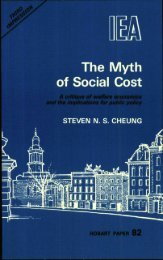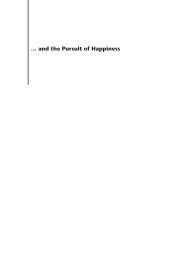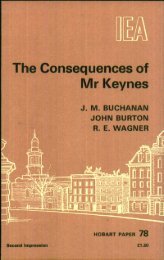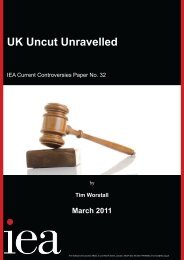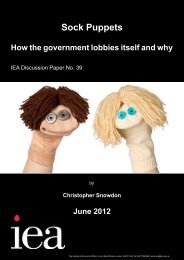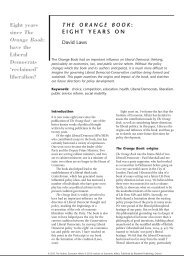Hayek's The Constitution of Liberty - Institute of Economic Affairs
Hayek's The Constitution of Liberty - Institute of Economic Affairs
Hayek's The Constitution of Liberty - Institute of Economic Affairs
You also want an ePaper? Increase the reach of your titles
YUMPU automatically turns print PDFs into web optimized ePapers that Google loves.
h ay e k ’ s t h e c o n s t i t u t i o n o f l i b e r t y<br />
s t o p p i n g c o e r c i o n i n e m p l o y m e n t<br />
<strong>Economic</strong> and political dangers<br />
Hayek’s principled objection to coercive unionism is that it<br />
violates the Rule <strong>of</strong> Law. But he also argues that union wage<br />
policy is ‘economically very harmful and politically exceedingly<br />
dangerous’ (272). Some <strong>of</strong> these economically harmful consequences<br />
– distortion <strong>of</strong> the wage structure, unjustified inequalities<br />
among workers, diminished productivity – we have mentioned.<br />
Union activities also restrict the mobility <strong>of</strong> labour, disadvantage<br />
some industries more than others, and (<strong>of</strong>ten in collusion with<br />
enterprise) produce monopolies that limit competition (280–81).<br />
But why, besides causing economic harm, are union policies<br />
‘exceedingly dangerous’ politically? Hayek fears that these policies<br />
will lead to a ‘system <strong>of</strong> over-all socialist planning’ (273) or ‘the<br />
transformation <strong>of</strong> the whole <strong>of</strong> society into a centrally planned<br />
and administered system’ (282).<br />
Hayek identifies two distinct but related causes that can<br />
produce this dangerous result: the crippling <strong>of</strong> market allocations;<br />
and runaway inflation. <strong>The</strong> first point is that unions, by<br />
establishing monopolies in the supply <strong>of</strong> labour, ‘prevent competition<br />
from acting as an effective regulator <strong>of</strong> the allocation <strong>of</strong> all<br />
resources.’ Yet the only alternative to the market as a means <strong>of</strong><br />
such regulation is ‘direction by authority,’ which in practice would<br />
mean central planning by the state (272–3). Hayek’s second point<br />
is that steep and prolonged inflation, resulting from an uncontrollable<br />
wage–price spiral, will eventually cause serious public alarm<br />
and provoke demands ‘either for the fixing <strong>of</strong> wages by government<br />
or for the complete abolition <strong>of</strong> the unions’ (282).<br />
Union wage policies cannot alone cause inflation to grow.<br />
Excessively high wages would simply produce job losses, if government<br />
did not expand the supply <strong>of</strong> money and credit in order to<br />
ensure full employment (see 337). Hayek attributes this ruinous<br />
governmental policy to Keynesian economics. Keynes recognised<br />
that excessively high wages cause extensive unemployment, but<br />
at the same time he saw that any direct attempt to lower wages<br />
would require ‘a struggle so painful and prolonged that it could<br />
not be contemplated.’ Keynes’s solution was to lower real wages<br />
by lowering the value <strong>of</strong> money: ‘If labor insists on a level <strong>of</strong><br />
money wages too high to allow <strong>of</strong> full employment, the supply <strong>of</strong><br />
money must be so increased as to raise prices to a level where the<br />
real value <strong>of</strong> the prevailing money wages is no longer greater than<br />
the productivity <strong>of</strong> the workers seeking employment’ (280).<br />
A full employment policy requires the monetary authorities<br />
to ‘provide enough money to secure full employment at any<br />
given wage level.’ Such a monetary policy creates expectations <strong>of</strong><br />
rising inflation. If the money supply is tightened to stop inflation,<br />
substantial unemployment will quickly result, bringing about ‘a<br />
renewed and irresistible pressure for more inflation’ (281). Eventually<br />
the public, alarmed by spiralling inflation, will demand the<br />
drastic actions mentioned above – wage-fixing by government<br />
and even the abolition <strong>of</strong> unions. While opposing the goal <strong>of</strong> full<br />
employment, Hayek does hold that it is possible to secure ‘a high<br />
and stable level <strong>of</strong> employment’ while aiming at the stability <strong>of</strong><br />
some comprehensive price level (337).<br />
Hayek is no fatalist. He holds out hope that the dangers he<br />
foresees from coercive unionism can be averted. This would<br />
require that unions conform to the Rule <strong>of</strong> Law, which in practice<br />
means that government would prevent unions from using<br />
coercion to attain their goals. Hayek does not wish to eliminate<br />
unions, for this would violate their freedom <strong>of</strong> association. In fact,<br />
he emphasises that unions would continue to have ‘a useful and<br />
162<br />
163



